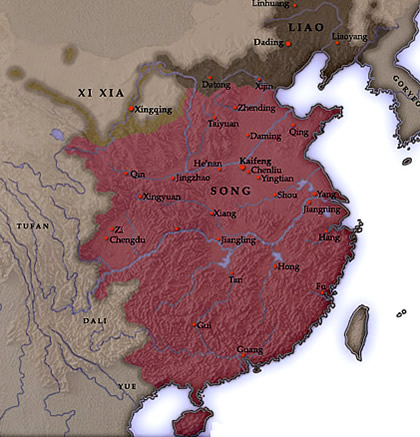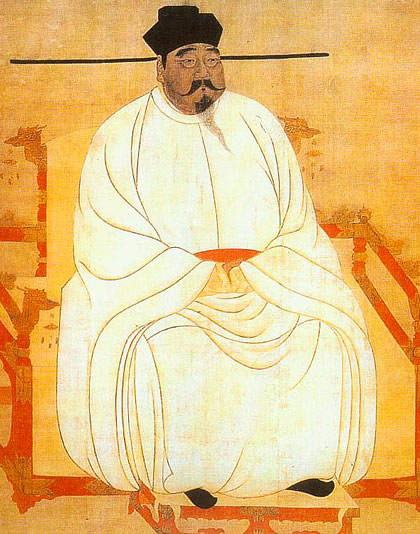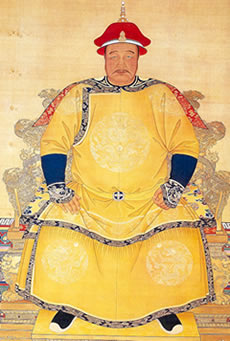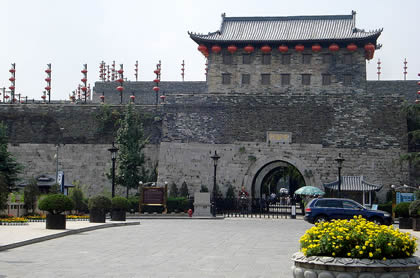 |
| Nothern Song |
The Song dynasty (960–1279) was founded by Zhao Kuangyin (Chao K’uang-yin), r. 960–976, and is known posthumously as Song Taizu (Song T’ai-tsu) or Grand Ancestor of Song.
After the fall of the Tang (T’ang) dynasty in 907 China had been divided with the northern part ruled by a succession of short-lived regimes called the Five Dynasties of China, while southern China was divided between 10 province-sized minor ruling houses. Zhao Kuangyin was an important general serving the last of the Five Dynasties, the Later Zhou.
He became emperor as a result of a mutiny conducted by his troops. Fearful that the same soldiers and their officers could depose him as easily as they had raised him to the throne, he immediately set out to persuade the leading generals to retire on generous pensions, replacing them with anabawang officers loyal to him.
In forming his new government Taizu made the military subordinate to civilians and rotated commanders and garrisons to discourage the formation of strong bonds between them.
He also made the army a professional one based on long-term enlistment and fostered policies that discouraged martial pursuits. According to a popular saying, “Good iron is not used to make nails; good men do not become soldiers.” No military uprisings or significant domestic revolts troubled the dynasty.
Northern Song, 960–1127
Taizu used a combination of persuasion and military action to annex the 10 states in the south. However he did not take on two border states: Liao in the nort heast, ruled by nomadic people called Khitan, and Xixia (Hsi Hsia) in the northwest, ruled by seminomads called Tangut, even though they occupied territories that had been part of the Tang empire.
 |
| Song Taizu |
To prevent a repetition of the Song dynasty’s falling after Taizu’s death because of no able heir to take over, Taizu’s mother made him promise to make his younger brother his heir, rather than his young son, when she lay dying in 961.
The younger brother, who was already a seasoned general, succeeded in 977 and reigned until 997 as Taizong (T’ang-tsung). When Taizong died the Song dynasty had been in power for almost four decades and was well established.
Taizong twice attempted to recover lands inside the Great Wall that Liao had seized; they totaled 16 prefectures and included an important city that is today called Beijing. He failed both times.
In 1004 Liao and Song concluded the Treaty of Sangyuan, which defined the boundary, established frontier markets, and stipulated annual payment by Song to Liao of 100,000 ounces of silver and 200,000 bolts of silk (the amount was increased by 100,000 units each later) that Song called gifts and Liao called tribute.
Except for minor wars the two sides lived in peace for a century. Song also fought an inconclusive war against Xixia between 1040 and 1044, which ended when Song agreed to give Xixia annual gifts of 200,000 ounces of silver and 200,000 bolts of silk.
Song was willing to buy peace rather than fight, arguing that the total gifts amounted to no more than 2 percent of its annual income. The Song government focused on defense, rebuilding sections of the Great Wall, fortifying frontier towns, and deploying a large army of 1,250,000 men.
Finding good horses for a cavalry was a duduk perkara because Song had inadequate horse breeding lands and Liao and Xixia, which did, would not sell horses to Song. An alternate policy of subsidizing farmers to raise horses, which the government could requisition in war, failed.
Taizu and his successors strengthened the central government by expanding the school and examination systems from which the bulk of civil servants were recruited. Advancement in printing and a fast growing economy produced a large and prosperous middle class whose educated sons found honor in serving the government.
A Confucian revival that began in the late Tang dynasty gained dynamism under Song. Confucian scholar-officials reinterpreted the teachings of Confucius and his early followers that successfully challenged Buddhist teachings.
Cut off from contact with India, Buddhism’s original home, by Muslims and others who ruled Central Asia, Chinese Buddhism lost its vitality during the Song era. The reinterpreted Confucianism that matured during Song is called Neo-Confucianism and was accepted as orthodox in China, Korea, and Japan until the 20th century.
Song scholar-officials formed two parties called Conservatives and Innovators that debated each other on taxation and other government policies. Each party implemented policies according to its ideals when in ascendancy.
At its height around 1100 the Song population totaled around 100 million, more than that of the larger earlier Han and Tang empires. Urban centers flourished, a national market system boosted trade, new seeds and crops increased food production, and many crafts provided a wide range of products.
True porcelain was produced for the first time in the world with high temperature kilns; the products of the many kilns were exported by land and sea throughout Japan, Southeast Asia, the Middle East, and Egypt.
The many craftsmen required in producing the ceramic wares worked in a fashion that resembled the division of labor of modern assembly lines. Song is also famous for literature of many forms and paintings; they reached their zenith under the eighth emperor, Huizong (Hui-tsung), who reigned between 1101 and 1125.
Huizong’s extravagant patronage of the arts and lavish spending on palaces and gardens strained the treasury, and his neglect of governing resulted in factional conflicts.
Finally his disastrous foreign policy almost ended the dynasty. Huizong stopped appeasing Liao and made an alliance with a new nomadic people called Jurchen in northern Manchuria who had newly established a state called Jin (Chin).
Their common goal was to destroy Liao by a pincer attack and to share the spoils. The war fought between 1118 and 1125 destroyed Liao but the alliance collapsed, and Jin then marched on the Song capital, Kaifeng (Kai-feng).
Ill prepared, Huizong abdicated, leaving his son Qinzong (Ch’in-tsung) to face the consequences. An abortive peace ended when Jin renewed its attack, capturing Kaifeng, then called Bian (Pien), in 1127 and taking both Song rulers and 3,000 members of their family and court to captivity in Manchuria. In retrospect the period 960–1127 is called Northern Song.
Southern Song
 |
| Southern Song |
The period 1127–1289 is called Southern Song. A younger son of Huizong eluded capture, rallied Song troops, and continued fighting until a peace treaty was signed in 1142 when Jin realized it could not conquer southern China; the new Song ruler, Gaozong (Kaotsung), r. 1127–1162, was resigned to losing northern China.
The most important military jagoan of the Song era, General Yue Fei (Yueh Fei), had been signally successful in resisting Jin forces and had advanced to the Yellow River valley.
But Song appeasers led by Qin Gui (Ch’in K’uei) had General Yue imprisoned on false charges and murdered in jail, perhaps as a peace offering to Jin. Yue became a great Chinese hero, admired and venerated in popular religion for his patriotism, while Qin has been despised for his treachery.
There were two revisions of the Song-Jin treaty, each adjusting the payment Song made to Jin. Gaozong is regarded as a second dynastic founder; he salvaged a desperate situation and gave the Song another lease on life, albeit in a smaller territory. Most of his successors were undistinguished and relied on powerful chancellors and ministers.
The capital of Southern Song was Hangzhou (Hangchou), once called Linan, near the coast south of the Yangzi (Yangtze) River. The Huai River became the boundary between Jin and Southern Song.
Southern Song was required to recognize Jin as a superior state and became its vassal and paid it an annual tribute of 200,000 ounces of silver and 200,000 bolts of silk. Southern Song prospered and Hangzhou became a great metropolis, surpassing Kaifeng.
Learning flourished, and southern China flourished as never before. Many great seaports grew along the southern coast because seaborne trade replaced land trade along the Silk Road (now traversing lands beyond Southern Song control).
Chinese ships, navigated by the compass (first used by Chinese navigators around 1100), with capacity between 200 and 600 tons, dominated the seas, carrying Chinese ceramics and other goods to Japan, Southeast Asia, and southern Asia. Taxes on trade produced the revenues needed to pay the annual tribute to Jin and to pay for the army.
 |
| Song dynasty painting |
Around 1200 the situation in northern China was dramatically changed by the rise of Mongols under Genghis Khan. After uniting the Mongol tribes under him, Genghis began attacking Jin in 1210. His forces took and destroyed Jin Central Capital (modern Beijing) in 1215 and many other cities in northern China.
Genghis left the Jin campaign unfinished to turn westward, destroying Xixia in 1227. In 1232 Song repeated the mistake that Huizong had made in 1118 when he made a treaty with Jin against Liao—it made an alliance with the Mongols against Jin, which was destroyed in 1234.
However instead of regaining parts of northern China, Song was faced with the formidable Mongols in 1245. Song forces resisted desperately, both sides using gunpowder and firearms.
Mongol forces were initially stymied by the strongly fortified Song cities and had problems fighting in the river- and canal-intersected terrain of southern China. The great Song fortress Xiangyang (Hsiang-yang) in modern Hubei (Hupei) province north of the central Yangzi valley held up for four years in 1273.
Finally Persian siege engineers and starvation forced Xiangyang’s surrender, which opened up the route to conquer the south. The Mongols also built a navy. The last adult Song emperor died in 1274; two years later Hangzhou surrendered without a fight.
Three infant emperors succeeded one another until 1279 when the last one drowned near Guangzhou (Canton) in 1279 as his remnant navy was overwhelmed by the Mongol fleet.



















